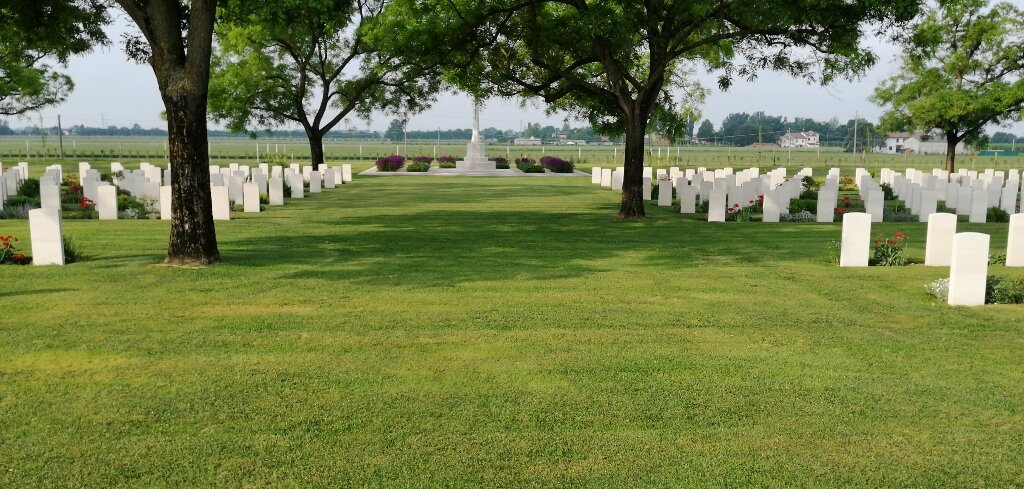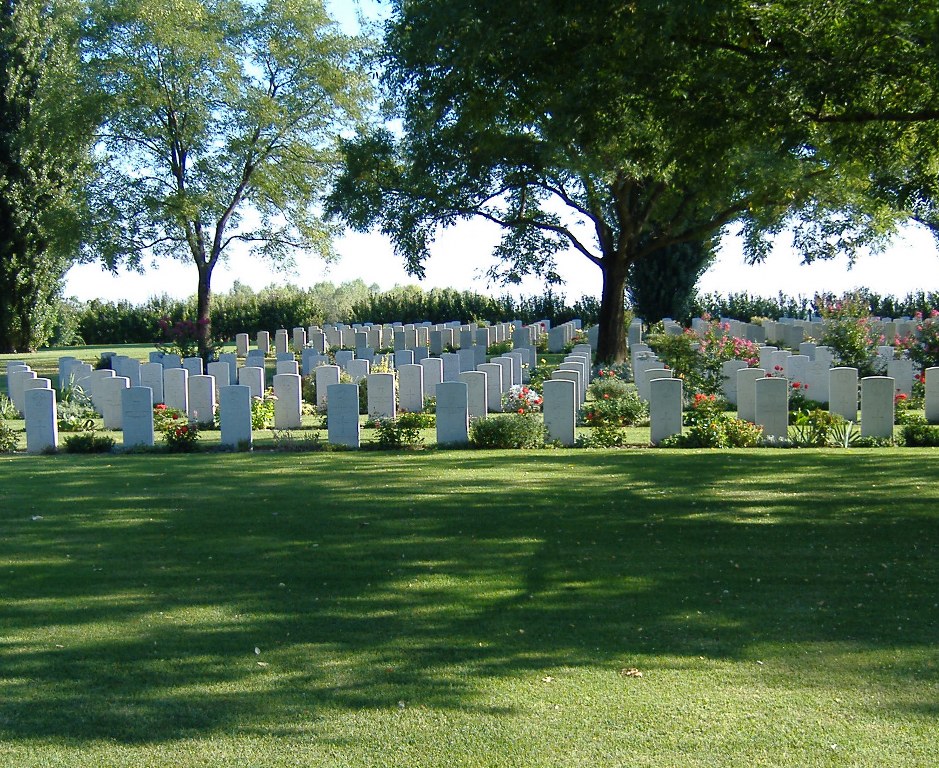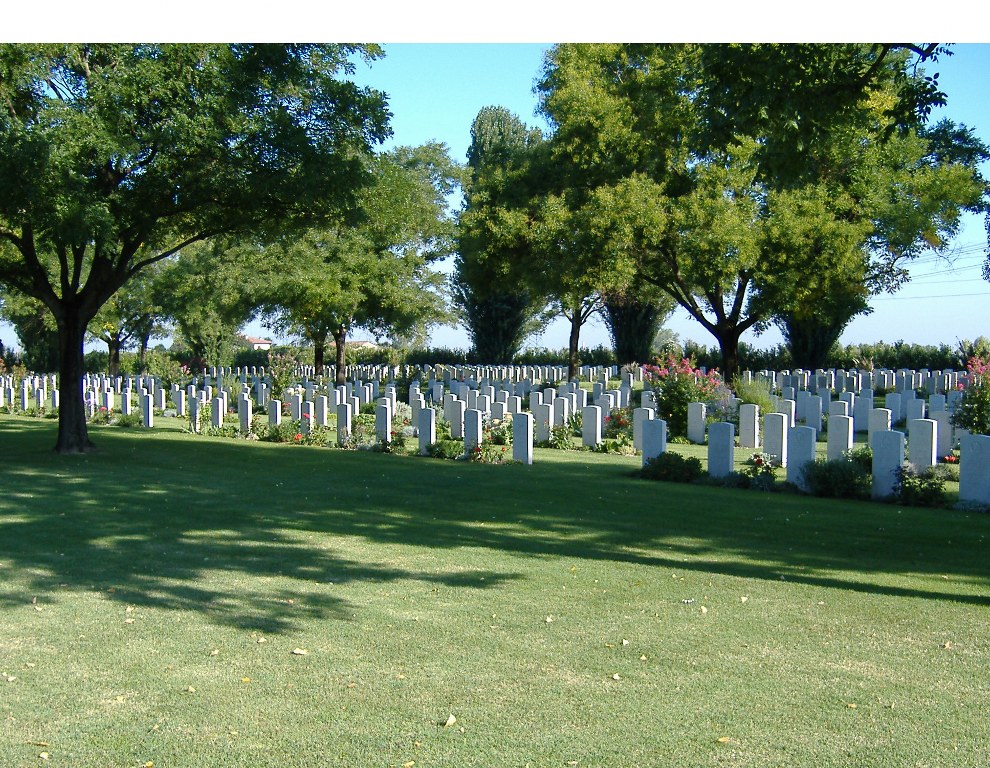Ravenna War Cemetery
- Country Italy
- Total identified casualties 926 Find these casualties
- Identified casualties from First & Second World War
- GPS Coordinates Latitude: 44.44185, Longitude: 12.10713
Location information
The War Cemetery lies on a communal road 1 kilometre south of the SS16 from Ravenna to Ferrara near the village of Piangipane in the Commune and Province of Ravenna. The turning from the main road is at the 143 kilometres stone, 12 kilometres west of Ravenna. The turning is marked with a CWGC sign pointing in the direction of the cemetery, and a road sign marked 'Piangipane 4 kilometres'. Continue along the minor road until a further CWGC sign is seen. The entrance to the cemetery is located on the left hand side of the road. The nearest train station to the cemetery is Mezzano but there is no taxi service available from there. There is however, a taxi service from Ravenna train station. Cemetery address: Via Piangipane 24B - 48100 Piangipane (RA) Emilia Romagna. GPS Co-ordinates: Latitude: 44.441525, Longitude: 12.107673.
Visiting information
RAVENNA WAR CEMETERY
The cemetery is off the road from Ravenna to Ferrara, close to the village of Piangipane in the province of Ravenna, Italy.
ARRIVAL
The route to the cemetery is signposted.
PARKING
There is a car park for approximately 4 vehicles at the front of the cemetery, approximately 200 metres from the main entrance gate.
The surface is compacted gravel; the ground is flat.
ACCESS, LAYOUT AND MAIN ENTRANCE
The cemetery is rectangular shaped.
The main entrance is at the end of a grassed access route. There is a tall (approximately 2.5 metres high) double metal gate. The opening is approximately 2.5 metres wide with the gate sections each 1.10 metres wide. One gate section is always open.
The cemetery is on a slight slope uphill from the Cross of Sacrifice down towards the last row of headstones at the opposite end of the cemetery. There is a paved area surrounding the Cross of Sacrifice.
There is a stone shelter on the right side at the main entrance. The Register box is inside the shelter. There is a step, approximately 100 mm high leading up to the shelter. There are stone benches inside and an unshaded wooden bench in the cemetery just inside the entrance gate.
The internal paths of the cemetery are grass.
ADDITIONAL INFORMATION
The cemetery is permanently open.
History information
On 3 September 1943 the Allies invaded the Italian mainland, the invasion coinciding with an armistice made with the Italians who then re-entered the war on the Allied side.
Following the fall of Rome to the Allies in June 1944, the German retreat became ordered and successive stands were made on a series of defensive lines. In the northern Appenine mountains the last of these, the Gothic Line, was breached by the Allies during the Autumn campaign and the front inched forward as far as Ravenna in the Adratic sector, but with divisions transferred to support the new offensive in France, and the Germans dug in to a number of key defensive positions, the advance stalled as winter set in.
Ravenna was taken by the Canadian Corps at the beginning of December 1944, and the burials in the cemetery there reflect the fighting for the Senio line and the period of relative quiet during the first three months of 1945. Many of the men buried there were Canadians; one of the last tasks of the Canadian Corps before being moved to north-west Europe was the clearing of the area between Ravenna and the Comacchio lagoon. Others are Indians from the 10th Indian Division, and New Zealanders. The site for the cemetery was selected by the Army in 1945 for burials from the surrounding battlefields.
Ravenna War Cemetery contains 955 Commonwealth burials of the Second World War, 63 of them unidentified. There are also 33 First World War burials, 30 of them brought in from Gradisca Communal Cemetery in 1973, the others from communal cemeteries at Arzigano, Fano and Monterosso al Mare. Among those buried in the cemetery are 33 men of the Jewish Infantry Brigade Group which was formed in September 1944, chiefly by volunteers from Palestine; the burials at Ravenna form the largest concentration of casualties from the Brigade.
There is 1 Merchant Seaman whose death is not attributable to war service and 1 French burial.






